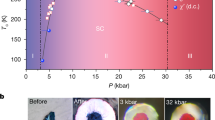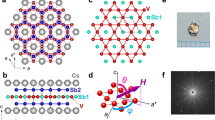Abstract
IT has been found experimentally,1 that the equivalent conductivity of glasses of the system B2O3 + Na2O increases very sharply (a million-fold) with the concentration of sodium in the glass. This increase begins at a definite concentration, about 3–5 per cent Na2O. In order to elucidate the nature of these facts, the velocity of solution of the glasses was measured. These experiments have shown that with this system the curve of the rate of solution has a maximum and, further, a sharp fall in a certain region of concentration of Na2O corresponding to the very beginning of the increase of equivalent conductivity (Fig. 1). Analysis of the quantitative data of the rate of solution indicates that orientation of polar molecules of borates of sodium in this region occurs.2 According to Tamman's well-known data, there exist in the B2O3 glass certain positions unoccupied by molecules (free positions).3 It is easy to conclude that in the region of the increase of the equivalent conductivity, the increase of orientation of the molecules leads to their more compact packing, and this, in its turn, leads to the disappearance of free positions (positions unoccupied by molecules). In the region of small concentrations of Na2O, the molecules of the borates of sodium are separated from each other and practically do not interact. Elementary considerations, which we here omit, make it possible to assume that the layers of the B2O3 molecules disappear among the polar molecules of the borates of sodium just in the region where equivalent conductivity begins to increase. It is therefore natural to expect the appearance in this region of a tendency to orientation among the molecules of borates, and at the same time a decrease of the energy of their dissociation as a result of their interaction. Owing to this, we obtain a great increase of conductivity, caused, as we know, by the sodium ions.
This is a preview of subscription content, access via your institution
Access options
Subscribe to this journal
Receive 51 print issues and online access
$199.00 per year
only $3.90 per issue
Buy this article
- Purchase on Springer Link
- Instant access to full article PDF
Prices may be subject to local taxes which are calculated during checkout
Similar content being viewed by others
References
S. Schtschukarew u. R. Müller, Z. phys. Chem., 150, A, 439; 1930.
G. Tamman, Z. anorg. Chem., 90, 297; 1915.
G. Tamman u. E. Jenkel, Z. anorg. Chem., 184, 716; 1929: 186, 171; 1930.
G. v. Hevesy, Z. Physik., 2, 178; 1920.
J. Frenkel, Z. Physik., 35, 652; 1924.
R. Schwarz u. J. Halberstadt, Z. anorg. Chem., 199, 33; 1931.
Author information
Authors and Affiliations
Rights and permissions
About this article
Cite this article
MÜLLER, R. Nature of the Ionic Conductivity of Glass. Nature 129, 507–508 (1932). https://doi.org/10.1038/129507a0
Issue Date:
DOI: https://doi.org/10.1038/129507a0
Comments
By submitting a comment you agree to abide by our Terms and Community Guidelines. If you find something abusive or that does not comply with our terms or guidelines please flag it as inappropriate.



